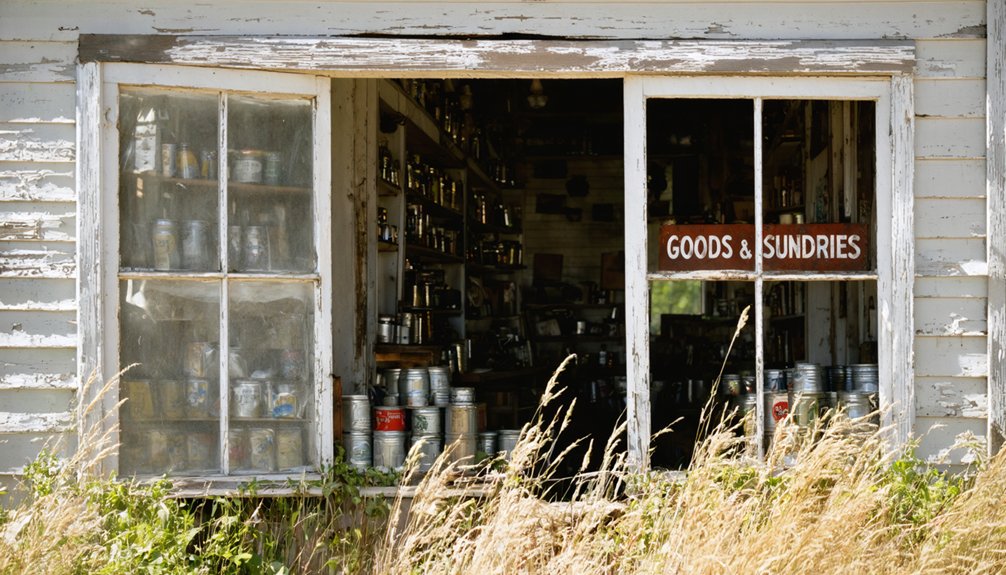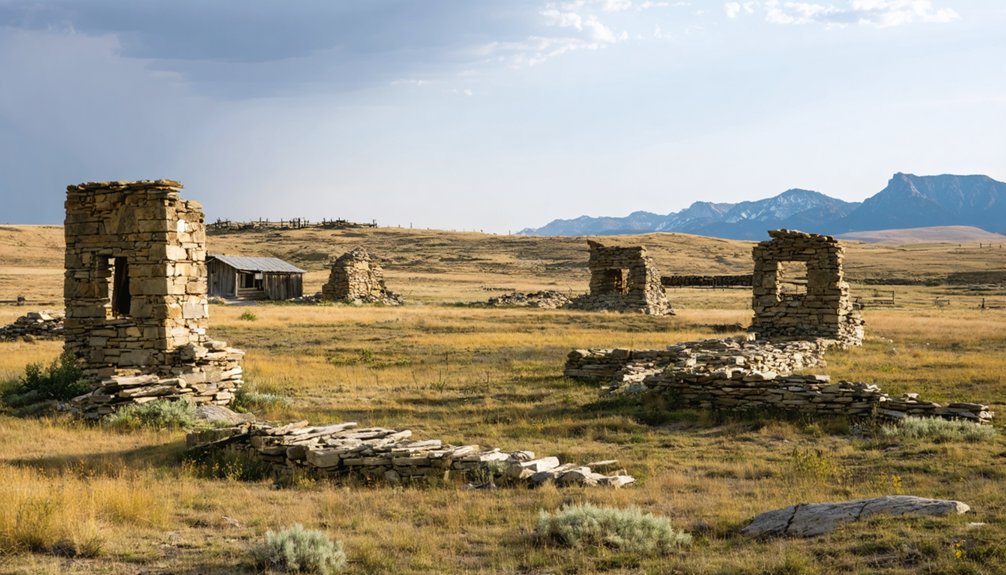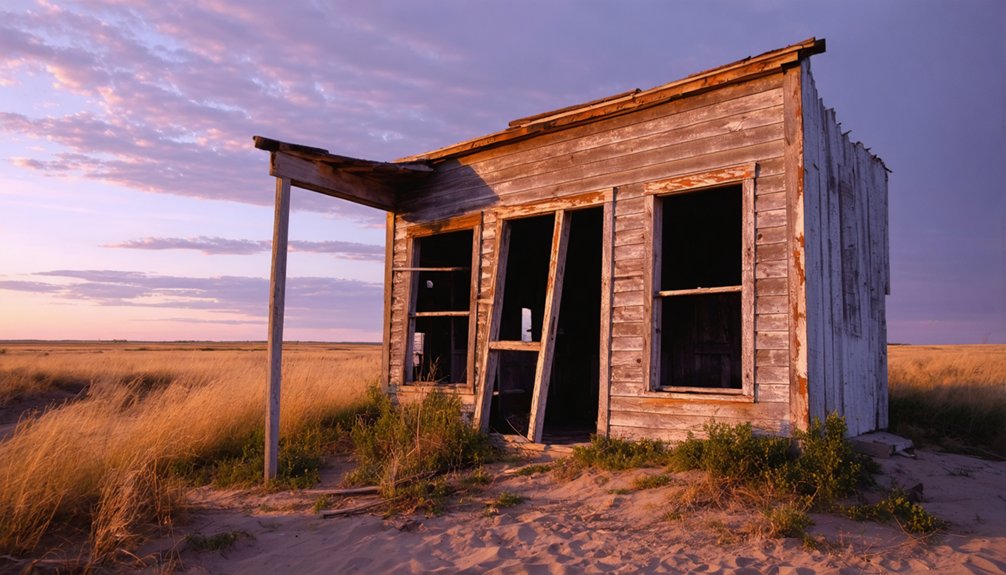You’ll find Lost Camp hidden somewhere in South Dakota’s Black Hills near Central City and Lawrence County, though its exact location remains a mystery. This former mining settlement has vanished from maps and official records, with no remaining structures or markers to pinpoint its position. You can access the approximate site via Iron Mountain Road 16A near Spokane Creek Campground, but the rugged terrain and sparse documentation make this ghost town‘s story particularly intriguing.
Key Takeaways
- Lost Camp was a mining settlement in South Dakota’s Black Hills, with its exact location disputed between Central City and Lawrence County.
- No structural remains exist today, though the site can be accessed via Iron Mountain Road 16A near Spokane Creek Campground.
- The settlement is absent from official census records between 1850-1945 and lacks substantial documentation in state historical archives.
- Historical maps show inconsistent locations for Lost Camp, with its last known reference appearing on early Black Hills mining-era maps.
- The site is now unmarked grassland requiring a 15-minute hike to access, with no visible foundations or commemorative markers remaining.
The Mystery Behind Lost Camp’s Location
While historians and locals have long speculated about Lost Camp‘s exact whereabouts in South Dakota’s Black Hills, its precise location remains one of the region’s most enduring mysteries.
You’ll find local legends pointing to various sites near Central City and throughout Lawrence County, where the geological significance of mineral deposits once drew prospectors in droves.
The rugged, mountainous terrain of the Black Hills has complicated efforts to pinpoint the site.
Steep cliffs and dense forests of the Black Hills create a natural barrier, shrouding Lost Camp’s location in perpetual mystery.
Time and weather have erased many potential markers, while the boom-and-bust nature of mining settlements means few reliable maps exist from that era.
Though you might stumble across old mining equipment or foundation remnants while exploring the area, distinguishing Lost Camp’s artifacts from those of other abandoned mining camps presents a significant challenge for modern-day adventurers. The presence of calcite and siderite deposits in the region suggests significant mining activity occurred in the vicinity.
Similar to Kami Golembeski’s experience, visitors can explore the area by staying at Spokane Creek Campground which provides convenient access to nearby ghost town sites.
Historical Records and Documentation
You’ll find frustratingly few official records about Lost Camp, with most documentation limited to vague references on early 1900s Sanborn fire insurance maps and scattered mentions in Lawrence County archives.
While these maps confirm the existence of the Calloway Hotel and suggest Lost Camp was a settlement area, they fail to show individual structures or provide detailed census information about the population.
Much like ghost town hunting involves patient research, historical documentation requires extensive investigation through multiple sources to uncover accurate information.
The town’s submergence beneath Pactola Reservoir has further complicated efforts to verify historical details, leaving researchers to piece together its story from fragmentary archival evidence and local accounts. Similar to many South Dakota towns, oral and written history remains the primary source for understanding Lost Camp’s legacy and cultural significance.
Sparse Official Records Found
The historical record of Lost Camp remains particularly sparse in South Dakota’s official archives, with minimal documentation found in state historical society collections.
You’ll find that archival challenges have severely limited research into Lost Camp’s historical significance, as government documents and official surveys from the era provide little concrete evidence of the settlement’s existence.
Unlike other Black Hills ghost towns, Lost Camp lacks dedicated historical markers or thorough surveys.
You won’t discover much in military records, postal documentation, or land surveys, as the town appears to have operated without an official government presence.
The settlement’s story emerges mainly through scattered map notations and local folklore, making it challenging to piece together its true role in South Dakota’s mining history.
Similar to how Lake Pactola flooded an entire mining community, Lost Camp’s physical remnants may have been lost to natural forces over time.
Maps Show Vague Location
Historical maps of South Dakota’s Black Hills region cast doubt on Lost Camp‘s exact whereabouts, adding another layer of mystery to its already scant documentation.
The map inaccuracies from the late 1800s through early 1900s reflect the settlement’s diminishing historical significance, as even detailed USGS surveys struggled to pinpoint its location. Similar to West Virginia Mine, which marked the town’s founding in 1880, several key landmarks have been lost to time. Today, the area has transformed into a recreational destination where visitors enjoy swimming and fishing activities.
- Maps from the era often omitted Lost Camp entirely or placed it inconsistently
- Settlement appears roughly “1/2 mile” from a larger town, but precise coordinates remain elusive
- Multiple map revisions show conflicting locations for the camp
- USGS surveyors frequently misplaced or renamed similar mining settlements
- Post-1900 maps hint at possible name changes, further complicating identification efforts
These cartographic inconsistencies make it nearly impossible for modern researchers to definitively locate Lost Camp’s original position.
Missing Census Information
Despite extensive searches through federal, territorial, and state census records, Lost Camp‘s existence remains conspicuously absent from official population counts spanning 1850-1945.
You won’t find the settlement listed in Dakota Territory’s censuses from 1861, nor in South Dakota’s state censuses conducted between 1905-1945. This presents significant census challenges for researchers trying to trace Lost Camp’s settlement patterns. The State Census records reveal detailed population data for 1905, 1915, 1925, 1935, and 1945, yet Lost Camp remains notably missing from these documents.
The area’s early documentation falls under Iowa Territory (1860) and Dakota Territory (1870, 1880), but there’s no specific mention of Lost Camp in these records. Federal population schedules conducted every decade since 1790 offer no mention of the settlement either.
Even non-population schedules, including mortality and veterans records, fail to reference the settlement directly. If Lost Camp’s residents were counted, they’d likely be listed under surrounding county or township designations, making it nearly impossible to pinpoint the ghost town’s historical population.
Life in the Black Hills Mining Region
During the Black Hills Gold Rush of the 1870s, miners faced a challenging existence marked by harsh living conditions and constant physical demands. The mining lifestyle revolved around the daily struggle for survival and prosperity, as you’d find miner communities springing up around promising claims near towns like Deadwood and Lead. The discovery of gold by Custer’s military expedition in 1874 sparked the initial rush of prospectors to the region.
- You’d work long hours performing backbreaking labor in dangerous underground conditions.
- Your living quarters would be basic, often just a simple cabin or tent in the mining camps.
- You’d rely on nearby towns for supplies, entertainment, and essential services.
- You’d face extreme weather, from scorching summers to brutal winters.
- You’d find yourself part of a diverse social mix of prospectors, entrepreneurs, and outlaws.
Disappearance From the Maps

You’ll find that Lost Camp‘s historical records are remarkably sparse, with most documentation of the town having vanished alongside its physical remains.
The last known mapping reference to Lost Camp appears on early mining-era maps of the Black Hills region, though the exact date of its final cartographic appearance remains uncertain.
Its removal from subsequent maps likely stems from a combination of the region’s mining decline, the town’s remote location, and the evolving standards of cartographic documentation in South Dakota.
Missing Historical Records
While researching Lost Camp’s history, historians face a significant challenge due to the absence of extensive archival records. The historical significance of this ghost town remains difficult to verify, as you’ll find archival challenges at every turn.
- Official government and mining claim records are either missing or non-existent.
- Local newspapers and mining reports rarely mentioned the settlement.
- No detailed town plans or settlement descriptions exist in historical repositories.
- Contemporary photographs and firsthand accounts haven’t been found.
- Early maps reference the location but don’t show clear structural footprints.
The limited documentation suggests Lost Camp might’ve been a transient mining settlement that declined before thorough records could be established.
Economic downturns and rapid abandonment likely contributed to its sparse historical footprint.
Last Known Mapping Reference
As historical records suggest, Lost Camp never established a substantial presence on official maps, setting it apart from other Black Hills ghost towns.
You won’t find it on U.S. Geological Survey maps or Sanborn atlases, unlike nearby settlements that left clear cartographic footprints. This absence of mapping carries significant historical weight, as even the oldest available maps show no evidence of houses or permanent structures at the site.
The cartographic significance of Lost Camp lies in what’s missing rather than what’s recorded.
While other transient settlements in South Dakota typically left behind some documentation of their existence, Lost Camp remains uniquely invisible in the historical record. Its persistent absence from maps suggests it may have been more of a local reference point than an established community.
What Remains Today
Despite its historical potential as a significant settlement, Lost Camp has vanished entirely from South Dakota’s landscape, leaving no trace of its former civilization.
Today, when you visit the site located half a mile from the nearest landmark, you’ll find a stark indication of the ephemeral nature of abandoned structures and their historical significance.
The current state of Lost Camp is characterized by:
- Complete absence of any building foundations or structural remains
- Land that has likely reverted to pasture or empty fields
- No visible markers or commemorative signs
- Unmarked location approximately half a mile from nearest road
- Possible vegetation coverage typical of South Dakota’s grasslands
The site’s complete dissolution into the surrounding landscape makes it particularly challenging for history enthusiasts to connect with its past, as nothing remains to tell its story.
Comparing Lost Camp to Nearby Ghost Towns

Lost Camp’s complete disappearance sets it apart from other ghost towns in South Dakota’s Black Hills region.
While nearby abandoned settlements like Spokane and Castleton showcase visible ruins, foundations, and mining artifacts, you’ll find Lost Camp hidden beneath Pactola Reservoir’s waters.
Lost Camp lies silently underwater, while its neighboring ghost towns still display their crumbling bones above ground.
Most ghost towns faded due to economic decline when mining ventures failed or railroad routes changed course, but Lost Camp met a different fate when dam construction submerged it mid-20th century.
The town’s historical significance differs too.
While places like Deadwood boast connections to famous Wild West figures, Lost Camp’s legacy centers on outlaw miners and rumors of sunken treasure in its submerged bank vault.
Unlike the mining remains you can explore at Maitland Two Bit or Golden West, Lost Camp’s physical history remains locked underwater.
Planning Your Visit to the Site
Planning a visit to the submerged ghost town requires careful preparation and knowledge of the surrounding Black Hills region.
You’ll find Lost Camp across from Spokane Creek Campground, accessible via Iron Mountain Road 16A or nearby dirt roads, followed by a short 15-minute hike.
- Wear sturdy hiking boots and bring water, as there aren’t facilities at the ghost town site.
- Start at Spokane Creek Campground as your base, which offers parking and camping options.
- Watch for unstable structures and old mine shafts while exploring the foundations and ruins.
- Check weather conditions, as Black Hills storms can develop quickly.
- Consider staying in nearby Keystone if you prefer modern accommodations over camping.
These visitor tips and exploration advice will help guarantee a safe adventure while preserving this historic mining settlement for future generations to discover.
Frequently Asked Questions
Were Any Valuables or Artifacts Ever Discovered at Lost Camp?
Like a fading footprint in desert sand, you won’t find documented treasure hunts yielding valuables at this site. Historical artifacts typical of mining operations exist in surrounding areas, but Lost Camp’s discoveries remain unverified.
What Native American Tribes Originally Inhabited the Lost Camp Area?
You’ll find the Lakota and Dakota peoples, particularly the Lower Yanktonai Sioux, originally inhabited this area as part of their ancestral lands, shaping the region’s rich tribal culture and Dakota history.
Did Any Major Epidemics or Natural Disasters Affect Lost Camp?
You won’t find records of major epidemic impact or natural disaster recovery in Lost Camp. Though poor sanitation likely caused health issues, the town’s decline came from economic factors and reservoir flooding nearby.
What Was the Primary Language Spoken by Lost Camp Settlers?
Ever wonder about frontier communication? You’d have found mostly English spoken at Lost Camp, though German settlers likely used their native tongue privately while adopting English for broader community interactions.
Were There Any Documented Supernatural Occurrences at Lost Camp?
While you’ll find anecdotal reports of ghostly sightings near old mines and shadowy figures at night, there aren’t any officially documented paranormal investigations specific to Lost Camp’s supernatural claims.
References
- https://www.youtube.com/watch?v=Glucs_Rq8Xs
- https://www.sdhspress.com/journal/south-dakota-history-2-2/some-black-hills-ghost-towns-and-their-origins/vol-02-no-2-some-black-hills-ghost-towns-and-their-origins.pdf
- https://www.sdpb.org/rural-life-and-history/2023-08-21/some-black-hills-ghost-towns-and-their-origins
- https://www.blackhillsbadlands.com/blog/post/old-west-legends-mines-ghost-towns-route-reimagined/
- https://www.blackhillsescaperooms.com/lost-city-of-south-dakota/
- https://en.wikipedia.org/wiki/List_of_ghost_towns_in_South_Dakota
- https://www.legendsofamerica.com/south-dakota-ghost-towns/
- https://blackhillsvisitor.com/learn/pactola/
- https://973kkrc.com/south-dakota-underwater-ghost-town/
- https://en.wikipedia.org/wiki/Carbonate



